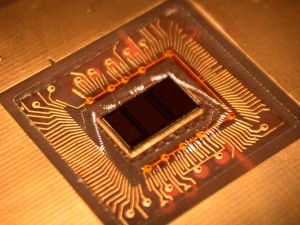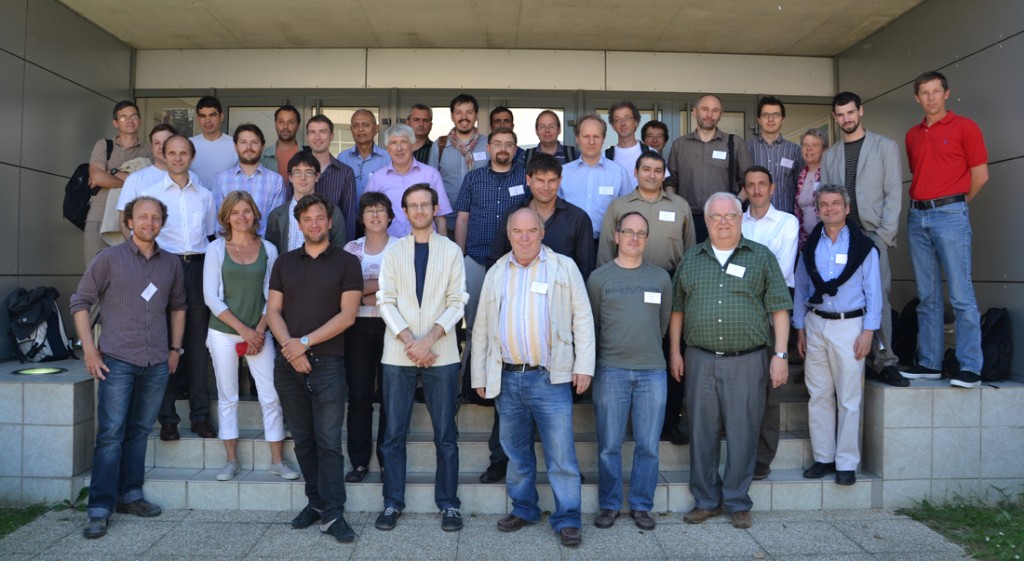
SPIROC readout ASIC, as designed for the current CALICE (CAlorimeter for LInear Collider Experiment collaboration) calorimeter prototypes. Photo: CNRS/LAL
Lowering power consumption is not only an earth-friendly undertaking. It is also a key issue for particle physicists to solve to design the next generation of collider experiments. Detectors will measure signals recorded in millions of readout channels. At the same time, the pulsed-bunch structure of the future lepton collider beams suggests that detectors should consume lower power between two bunches. How to power the readout circuitry and how to keep the power consumption of the front-end electronics can at a reasonable low level, were the topics of a first workshop on power pulsing and delivery held at LAL in Orsay, France on 9-10 May 2011. The workshop gathered 40 experts from the field, and was initiated by the International Linear Collider/ CLIC Design – the Compact Linear Collider (CLIC) Study common working group for detectors, and experts from the SLHC (Large Hadron Collider upgrade) community also participated.
Lowering power is key to reduce power budget of course, but also to reduce heat dissipation in the sub-detectors. The lepton collider detectors will have little space for active cooling and neither the electronic circuits nor the sensitive parts like heat. The baseline approach to control the power consumption of ILC and CLIC detectors is called power pulsing, which means that certain functions of the front-end electronics are periodically disabled, for instance between two bunch trains and only configuration registers will remain powered during that time. At the workshop, scientists discussed different solutions to deliver power to the front-end electronics. These solutions included the use of DC/DC (direct current to direct current) converters as it proposed for SLHC detectors, or large storage capacitances. Some speakers pointed out that industrial applications nowadays are targeting ultra-low power-consuming circuits, which may not needed to be power-pulsed. Future detector systems may benefit from this experience too.

Experts from ILC, CLIC and SLHC gathered at LAL in Orsay, France in May 2011, to discuss power pulsing and delivery for the next generation of particle detectors. Image: CNRS/LAL/Bruno Mazoyer
Representatives of the different subsystems presented the current status on their realisations in power delivery and power pulsing, indicating that some were more advanced than others. For example, the calorimeter groups have already successfully operated power-pulsed ASICs (application-specific integrated circuit) in a magnetic field in June 2010 at CERN. This achievement can clearly be regarded as a milestone towards the realisation of power-pulsed electronics for future particle detectors.
Beside the front-end electronics, the power management of detectors needs also to take into account peripheral devices like cooling. The workshop provided a forum to discuss these issues. Due to the limited space inside detectors, efficient cooling will be very challenging, in particular for the very inner parts of the detectors. These sub-component groups may work towards a common solution.
The workshop was extremely useful to identify the status of the considerations concerning the power management of detectors for lepton colliders. It was the first time where relevant figures and propositions were assembled in one place, which will be most useful for physicists and engineers working on detector integration.
But the story has just begun, and now our task as workshop conveners is to monitor the progress on this R&D and to make sure all subsystems groups work on a coherent approach, which will require good communication between them. A second workshop should be held in the first half of 2012. The conclusions of this next workshop will most certainly be part of the ILC detector Detailed Baseline Design Report.

Recent Comments